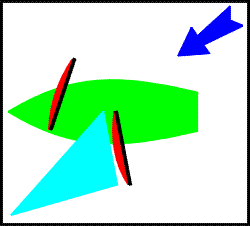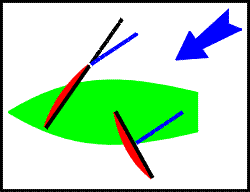|

I've been curious about being on the "right gybe", since I seem to be
on the "wrong" one most of the time. My Ikon is noticeably slower, by
comparison with the other boats, if it is on the wrong gybe. So what does
the "right" gybe look like? And how come the gybe can be right
sometimes and wrong the other times as the boat rounds a mark?
There seem to be two issues. The first is the simple issue that the
main sail should not blanket the jib. The wind is hardly ever directly
over the stern. Instead, it is on one aft quarter or the other, and the
diagram shows the problem if the main boom is on the same side as the wind's
quarter. The jib is clearly blanketed, and can't possibly be doing its
best job. Gybe, and the main now no longer blankets the jib, as the second
diagram shows. Much better.

The second issue, as the second diagram now hints, is that we might want to
think about the sheeting angles of main and jib, to get them to develop maximum
drive. If we draw the main in, so it is square to the wind, the jib makes
a rather shallow angle to the wind, and would be nowhere near square to the wind
itself. (We are talking about the IOM class here, really, because a jib
twitcher or jib servo is not permitted, and both main and jib sheets are
controlled by one line. Tighten the main, and you tighten the jib.)
But maybe that's just fine. By making a shallow angle, the jib is in fact
developing an angle of attack, this time with its leech as the leading edge, and
is developing some real lift. The jib is "sailing by the lee",
and there is evidence that it develops more drive this way than if it was square
to the wind. The third diagram shows this idea.
The jib boom needs to be at an angle of attack of about 20 degrees to the
wind. This presents the jib leech to the wind at an appropriate entry angle. The
angle of the main is not that important; anywhere between about 65 and 90 is
fine.

If you think you are going to be doing a lot of running at an angle, but not
much broad reaching, you might want to think about adjusting your sheet take off
on the jib boom. Increase the sheet attachment radius some; that should help
position the jib better for sailing by the lee.
The last question is, when does the boat settle on the "right" gybe
without difficulty, and when do you have to do something about it? The
short answer is that, as you sail from one leg of the course to another, you
generally settle on the right gybe so long as all you need to do is ease the
sheets as you assume your new course. The main will correctly settle to
the new wind direction, and it will be the jib that flips over to
goose-wing. But if the main gybes, or you have to tack around the mark,
you'll need to set the gybe you want with a little wiggling.
Your choice of gybe may also depend on whether you want or need to be on
starboard, of course, because of tactical considerations with nearby boats. But
you know that having boat speed makes you a tactical genius; in most situations
set the right gybe and have maximum speed, rather than set starboard gybe and
watch 'em all sail past regardless.
William Adamsen has e-mailed me an analysis of the gybe set based on his
full-size experience.
Tactically, what is the gybe you should set upon rounding the weather mark?
The proper gybe and set are one of the hardest concepts for new and even
experienced skippers to fully understand. Everyone quickly learns the
favoured upwind tack and learns oscillations, "climbing" a wind
ladder, etc. However, many skippers don't seem to apply the same
techniques downwind. It has been my observation from dinghy racing that
after a port weather mark rounding, virtually all skippers remain on starboard
tack. Why is this?
Well, there are obviously a number of factors. Tactics, wind
direction, wave action, clear air, strategic positioning, simplicity, habit,
fleet congestion, yacht performance, current.... Is there a statistical bias
that favours one tack (gybe) or another after the rounding? Specifically, how
often "should" a boat gybe set?
Let's first look at the wind direction. The wind alone in an absence of
other boats should provide a completely distributed statistical preference for
one tack (gybe) or the other. That is, if preferred tack were chosen based on
wind direction alone, you would chose a gybe set 50% of the time.
What about seeking clear air? One could argue that an even
distribution of boats on the approach to the windward mark (port and
starboard) would again provide for an even choice of downwind tacks. However,
one could also argue that there is a "biased" starboard side loading
due to rule 18.3 and skipper habit. Yet with most skippers slipping off
on starboard once rounding, the "starboard side" should be
relatively clear. Let's say 30% then.
Tactics and strategy would assume an even distribution. Perhaps it is
tricky to manoeuvre through the fleet as weather, port tack boat.
However, port gybe is certainly favoured for protection downwind as the fleet
closes. 50%?
Simplicity and habit become the biggest factors. Skippers like to
"set up" for roundings and rarely consider the "gybe set"
even if conditions clearly demand it. Habit may also be a factor.
Sailing the standard Olympic "triangle and sausage" conditions us to
round and remain on starboard. 0%?
I entered a race some time ago with a young sailor as forward crew who had
been sailing regularly with the fleet for four or five years. This was
at all levels of competition, but with a restricted group of sailors. We
made the weather mark in first and it was clear a gybe set was required.
She had never heard the term nor performed the manoeuver. Fortunately a
quick study, she performed her role, we completed the gybe successfully and
went on to win the race and the day of sailing. The question I asked
myself was, "How could someone who'd sailed as crew with many different
skippers and have raced what must have amounted to at least 200 races, never
performed a gybe set?" I gybe set on perhaps 30%+ of my weather
mark roundings, so in the same number of races I would have performed 80+ gybe
sets, surely enough to understand the concept. After the races in a casual
moment on the club deck, I enquired of one of her former skippers just how
often he gybe sets and under what conditions. "Never" he exclaimed,
"why, it upsets the crew!"
An informal poll of my sailing buddies reflects the same thinking. But the
better sailors seem to gybe between 20% and 40% depending on the type of boat
and the factors previously discussed.
2005-12-18 |
